![]() Sodium oleate
Sodium oleate
Rating : 7
| Evaluation | N. Experts | Evaluation | N. Experts |
|---|---|---|---|
| 1 | 6 | ||
| 2 | 7 | ||
| 3 | 8 | ||
| 4 | 9 | ||
| 5 | 10 |
10 pts from FCS777
| Sign up to vote this object, vote his reviews and to contribute to Tiiips.Evaluate | Where is this found? |
| "Descrizione" about Sodium oleate Review Consensus 10 by FCS777 (5554 pt) | 2024-Oct-14 16:52 |
| Read the full Tiiip | (Send your comment) |
Sodium Oleate is the sodium salt of oleic acid, a monounsaturated fatty acid commonly found in vegetable oils such as olive oil and sunflower oil. It is primarily used as an emulsifier, surfactant, and foaming agent in cosmetic and skincare products. Due to its ability to emulsify fats and oils, Sodium Oleate helps stabilize formulations and enhances cleansing by removing dirt and sebum from the skin and hair.
Chemical Composition and Structure
Sodium Oleate is a natural soap formed by the reaction of oleic acid with sodium hydroxide. Its chemical formula is C18H33NaO2, and it features a long hydrocarbon chain that makes it lipophilic, combined with a carboxylate group that provides water solubility. This structure makes it an excellent emulsifier for blending oily and aqueous substances, ideal in cleansing and moisturizing products.
The name describes the structure of the molecule:
- Sodium indicates the presence of sodium ions in the molecule.
- Oleate, derived from the word "oleic." It indicates that the molecule is a salt or ester of oleic acid, a monounsaturated fatty acid.
Description of the raw materials used in its production:
- Oleic Acid - Oleic acid is a monounsaturated fatty acid naturally found in various vegetable oils, such as olive oil and sunflower oil. It is extracted from these sources or chemically synthesized. Oleic acid is the main component of sodium oleate.
- Sodium - Sodium is a chemical element found in many compounds. In the production of sodium oleate, oleic acid reacts with sodium hydroxide (NaOH) to form sodium oleate. This chemical reaction involves the replacement of the hydroxyl group of oleic acid with a sodium atom.
Production Process
Sodium Oleate is produced through a saponification reaction, where oleic acid, derived from vegetable oils, reacts with sodium hydroxide (NaOH). This process creates the sodium salt of oleic acid, which is purified for use in cosmetic and skincare products.
- Saponification - Oleic acid is reacted with sodium hydroxide in a saponification reaction. During this reaction, the carboxylic acid group of oleic acid reacts with sodium hydroxide, forming sodium oleate and water. This reaction results in the formation of a sodium salt of oleic acid.
- Purification - The crude product obtained from the saponification reaction is purified to remove any impurities or by-products. This can be done through processes such as filtration, crystallization, or centrifugation.
- Drying - The purified sodium oleate is dried to remove residual moisture and obtain a powder or dry solid.
- Quality Control - The dried sodium oleate undergoes quality control checks to ensure its purity, stability, and compliance with industry standards.
Physical Properties
Sodium Oleate appears as a white powder or solid, soluble in both water and oils. At room temperature, it can form a stable foam, which makes it useful in soaps and detergents. It also has emollient properties, leaving the skin soft after cleansing. Its ability to stabilize emulsions makes it a key ingredient in creams and lotions.
It occurs as a white or yellowish powder that is soluble in water and ethyl alcohol; insoluble in benzene.
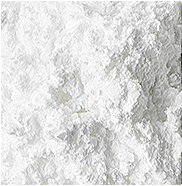
What it is used for and where
Medical
Sodium oleate can induce disturbances of lipid metabolism and lipid deposition in HepG2 cells (1). It is also considered to be an effective new therapy to improve antibiotic deficiency treatment towards biofilm resistance (2) and an improver of chrysin oral absorption (3).
Pure sodium oleate is used for the activation of protein kinase C in liver cells.
Cosmetics
Viscosity-stable anionic surfactant in the production of soaps, creams and personal care products as it improves the performance of polymer systems with regard to viscosity and other rheological properties.
Cleansing agent. Ingredient that cleanses skin without exploiting the surface-active properties that produce a lowering of the surface tension of the stratum corneum.
Surfactant - Emulsifying agent. Emulsions are thermodynamically unstable and are used to soothe or soften the skin and emulsify, so they need a specific, stabilising ingredient. This ingredient forms a film, lowers the surface tension and makes two immiscible liquids miscible. A very important factor affecting the stability of the emulsion is the amount of the emulsifying agent. Emulsifiers have the property of reducing the oil/water or water/oil interfacial tension, improving the stability of the emulsion and also directly influencing the stability, sensory properties and surface tension of sunscreens by modulating the filmometric performance.
Surfactant - Cleansing agent. Cosmetic products used to cleanse the skin utilise the surface-active action that produces a lowering of the surface tension of the stratum corneum, facilitating the removal of dirt and impurities.
Viscosity control agent. It controls and adapts, Increasing or decreasing, viscosity to the required level for optimal chemical and physical stability of the product and dosage in gels, suspensions, emulsions, solutions.
Other uses
- Plastics. Used in the processing of various soft PVC products, such as films, foils, cable materials and moulded products, artificial leather, Cold resistant plasticiser.
- Waterproofing agent in textiles.
- Food packaging with the exception of fatty foods.
- Nitrocellulose varnish, which makes the varnish film with increased elasticity tensile strength.
- Synthetic rubbers with good softening effect.
- Organic solvent and stationary liquid for gas chromatography (methanol and methylene chloride as solvent with a maximum use temperature of 150°C) separates various oxygenated, aromatic and unsaturated compounds.
- Mineral processing
Health and Safety Considerations
Safety in Use
Sodium Oleate is considered safe for use in cosmetics and personal care products. It is well tolerated by the skin and is not known to cause significant irritation when used in appropriate concentrations. Major regulatory authorities, such as the European Union and the FDA, permit its use in cosmetics.
Allergic Reactions
Allergic reactions to Sodium Oleate are rare. However, individuals with sensitive or reactive skin are advised to perform a patch test before use.
Toxicity and Carcinogenicity
It has been widely used and tested in personal care products and is considered safe for long-term use.
Environmental Considerations
Sodium Oleate is biodegradable and considered environmentally friendly. It is derived from renewable resources, such as vegetable oils, and poses no significant risk to the ecosystem when used properly.
Regulatory Status
Sodium Oleate is approved for use in cosmetic products by major regulatory authorities, including the European Union and the FDA in the United States. It is widely used in cleansers and formulations for skin and hair care.
Typical commercial product characteristics Sodium oleate
| Appearance | White powder to slightly yellow |
| Assay | ≥99.0% |
| Boiling Point | 359.999ºC at 760 mmHg |
| Melting Point | 232-235°C(lit.) |
| Flash Point | 270.099ºC |
| Density | 0.9 g/cm3 |
| Loss on drying | ≤5.0% |
| Free alkali | ≤0.5% |
| Fatty acid value | 195~204 |
| Iodine | 80~100 Gl/100g |
| Shelf life | 2 years |
| Storage | 2-8°C |
| PSA | 40.13000 |
| LogP | 4.77380 |
| pKa | 4.46(at 25℃) |
| Safety |  |
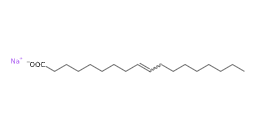 | 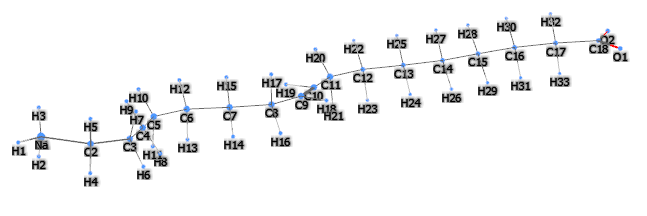 |
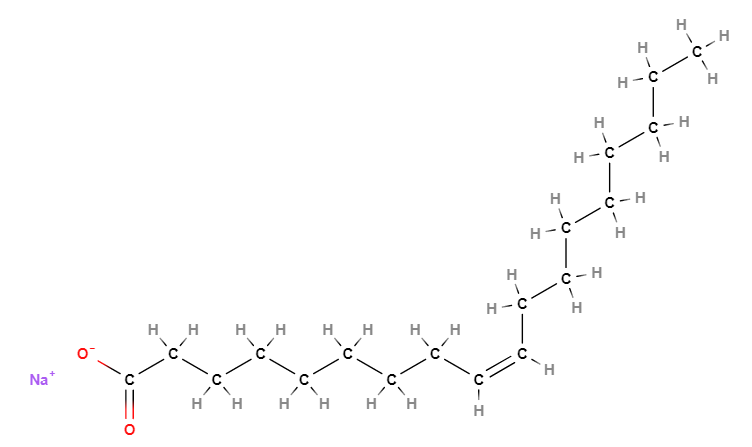 | 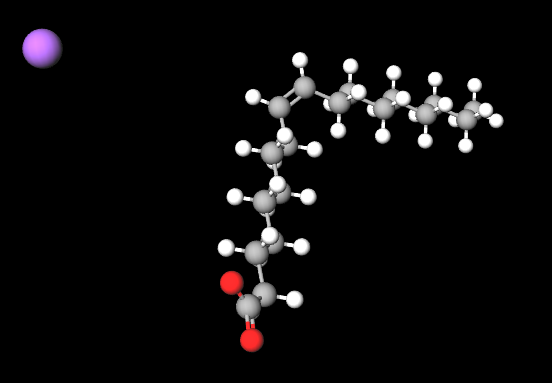 |
- Molecular Formula C18H33NaO2
- Linear Formula CH3(CH2)7CH=CH(CH2)7COONa
- Molecular Weight 304.4
- Exact Mass 304.237823
- CAS 143-19-1
- UNII 399SL044HN
- EC Number 205-591-0
- DSSTox Substance ID DTXSID7021077
- IUPAC sodium;(Z)-octadec-9-enoate
- InChI=1S/C18H34O2.Na/c1-2-3-4-5-6-7-8-9-10-11-12-13-14-15-16-17-18(19)20;/h9-10H,2-8,11-17H2,1H3,(H,19,20);/q;+1/p-1/b10-9-;
- InChl Key BCKXLBQYZLBQEK-KVVVOXFISA-M
- SMILES CCCCCCCCC=CCCCCCCCC(=O)[O-].[Na+]
- MDL number MFCD00004438
- PubChem Substance ID 24898044
- ChEBI 81860
- RXCUI 32559
- Beilstein 4046357
- RTECS RK1200000
- HS Code 2916150000
Synonyms
- Oleic acid, sodium salt
- sodium;(Z)-octadec-9-enoate
- Eunatrol
- Sodium 9-octadecenoate
- Olate flakes
- Sodiumoleate
- Sodiumoleate
- sodium (Z)-octadec-9-enoate
References___________________________________________________________________
(1) Norikura T, Mukai Y, Fujita S, Mikame K, Funaoka M, Sato S. Lignophenols decrease oleate-induced apolipoprotein-B secretion in HepG2 cells. Basic Clin Pharmacol Toxicol. 2010 Oct;107(4):813-7. doi: 10.1111/j.1742-7843.2010.00575.x.
(2) Mohamed AMHA, Vladimirovna SN, Grigorievich ZV, Borisovna PA, Ivanovich SV. Sodium Oleate Increases Ampicillin Sensitivity in Methylophilus quaylei Biofilms on Teflon and Polypropylene. Curr Pharm Biotechnol. 2019;20(3):261-270. doi: 10.2174/1389201020666190222191656.
(3) Dong D, Quan E, Yuan X, Xie Q, Li Z, Wu B. Sodium Oleate-Based Nanoemulsion Enhances Oral Absorption of Chrysin through Inhibition of UGT-Mediated Metabolism. Mol Pharm. 2017 Sep 5;14(9):2864-2874. doi: 10.1021/acs.molpharmaceut.6b00851.
Abstract. Oral bioavailability of flavonoids (and many phenolic drugs) is severely limited by extensive first-pass glucuronidation. Here we aimed to determine the modulatory effects of commonly used pharmaceutical excipients (PEs) on UDP-glucuronosyltransferase (UGT) activities and to evaluate the potential of nanoemulsions containing a UGT-inhibitory PE for oral absorption enhancement of chrysin, a model flavonoid. The effects of PEs on glucuronidation were determined using tissue (liver and intestine) microsomes, expressed UGT1A1 enzyme, and UGT1A1-overexpressing HeLa cells. Nanoemulsions were prepared using a modified emulsification technique and subsequently characterized by particle size, zeta-potential, morphology, and in vitro drug release. Pharmacokinetic studies were performed with rats to assess the effects of nanoemulsions on the metabolism and pharmacokinetics of chrysin. Of 21 PEs, five (i.e., Brij 35, Brij 58, labrasol, sodium oleate, and Tween 20) significantly inhibited chrysin glucuronidation. Of note, sodium oleate was the most potent inhibitor of glucuronidation. Eight PEs including Tween 80 had no effects on glucuronidation of chrysin. The chrysin nanoemulsions prepared with sodium oleate (named SO-NE) were spherical or near-spherical (particle size, 83.2 nm; zeta-potential, -43.7 mV; entrapment efficiency, 89.5%). The reference nanoemulsions prepared with Tween 80 (T80-NE) were highly similar to SO-NE in terms of particle size, zeta-potential, and drug release. It was demonstrated in pharmacokinetic studies that SO-NE led to a 4.3-fold increase in systemic exposure of chrysin and a 3.5-fold increase in Cmax value, whereas T80-NE did not cause any changes in chrysin pharmacokinetics. In conclusion, sodium oleate-based nanoemulsions greatly enhanced oral absorption of chrysin. Oral absorption enhancement of chrysin was attained through targeted inhibition of first-pass glucuronidation by sodium oleate.
| Sign up to vote this object, vote his reviews and to contribute to Tiiips.EvaluateClose | (0 comments) |
| "Sodium oleate studies" about Sodium oleate Review Consensus 10 by FCS777 (5554 pt) | 2022-May-07 16:52 |
| Read the full Tiiip | (Send your comment) |
Compendium of the most significant studies with reference to properties, intake, effects.
Chen C, Huo JS, Zhuo Q, Li Y, Ma Y, Wang JB, Jia XD. Lipid Accumulation and IL-6 Production in L02 Hepatocytes Induced by Sodium Oleate: Dose and Time Dependence. Biomed Environ Sci. 2021 Dec 20;34(12):998-1004. doi: 10.3967/bes2021.058.
Abstract. To explore interleukin-6 (IL-6) production and characterize lipid accumulation in L02 hepatocytes induced by sodium oleate.
Zhou S, Zhou W, Dong L, Peng Y, Xie G. Micellization Transformations of Sodium Oleate Induced by Gas Nucleation. Langmuir. 2021 Aug 17;37(32):9701-9710. doi: 10.1021/acs.langmuir.1c01008.
Abstract. The interfacial properties of surfactant solutions are closely related to the micellization of surfactants. Temperature, salt type and concentration, pH, and other parameters affecting the micellization of surfactants have all been extensively investigated previously. However, the effect of dissolved gas on surfactant micellization and associated interfacial properties' transformations is not completely understood yet. In this study, sodium oleate (NaOl) was chosen as the research object, and the role of gas/gas nucleation in NaOl micellization was systematically investigated.
Tatini D, Raudino M, Ambrosi M, Carretti E, Davidovich I, Talmon Y, Ninham BW, Lo Nostro P. Physicochemical characterization of green sodium oleate-based formulations. Part 1. Structure and rheology. J Colloid Interface Sci. 2021 May 15;590:238-248. doi: 10.1016/j.jcis.2021.01.040.
Abstract. This paper is the first report in which a moderately concentrated (13% w/w) dispersion of NaOL in water is investigated. In fact, at this concentration the phase and rheology behavior of the surfactant remarkably deviates from those of its dilute solutions in water and a significant effect is imparted by the addition of potassium chloride.
Dong D, Quan E, Yuan X, Xie Q, Li Z, Wu B. Sodium Oleate-Based Nanoemulsion Enhances Oral Absorption of Chrysin through Inhibition of UGT-Mediated Metabolism. Mol Pharm. 2017 Sep 5;14(9):2864-2874. doi: 10.1021/acs.molpharmaceut.6b00851.
Abstract. Sodium oleate (NaOl), a collector in diaspore flotation, has been widely used for more than 30 years, while its low selectivity becomes an issue under today's process requirement. This study introduced tert dodecyl mercaptan (TDM) together with NaOl as a mixed collector to improve selectivity in diaspore flotation.
Sintov A, Ze'evi A, Uzan R, Nyska A. Influence of pharmaceutical gel vehicles containing oleic acid/sodium oleate combinations on hairless mouse skin, a histological evaluation. Eur J Pharm Biopharm. 1999 May;47(3):299-303. doi: 10.1016/s0939-6411(99)00018-1.
Abstract. It was seen that the severity and frequency of histological changes in the skin treated with OA-containing vehicles were directly correlated with increased pH/ionization (i.e. decreased OA/sodium oleate ratio) and with overall OA concentration.
Llanos S, Giraldo LJ, Santamaria O, Franco CA, Cortés FB. Effect of Sodium Oleate Surfactant Concentration Grafted onto SiO2 Nanoparticles in Polymer Flooding Processes. ACS Omega. 2018 Dec 28;3(12):18673-18684. doi: 10.1021/acsomega.8b02944.
Abstract. The nanotechnology has been applied recently to increase the efficiency of enhanced oil recovery methods. The main objective of this study is to evaluate the effect of SiO2 nanoparticle functionalization with different loadings of sodium oleate surfactant for polymer flooding processes. The sodium oleate surfactant was synthesized using oleic acid and NaCl.
Barter PJ, Chang LB, Rajaram OV. Sodium oleate promotes a redistribution of cholesteryl esters from high to low density lipoproteins. Atherosclerosis. 1990 Sep;84(1):13-24. doi: 10.1016/0021-9150(90)90003-2.
Abstract. Cholesteryl esters readily exchanges between the low density lipoproteins (LDL) and high density lipoproteins (HDL) in human plasma in a process of equilibration catalysed by the cholesteryl ester transfer protein (CETP). In the present studies, in which mixtures of human LDL and HDL have been incubated in vitro with partially pure CETP, it has been found that Na oleate disrupts the CETP-mediated equilibrium between LDL and HDL and promotes a concentration dependent redistribution of cholesteryl esters from HDL to LDL.
Beneventi D, Pugh RJ, Carré B, Gandini A. Surface rheology and foaming properties of sodium oleate and C12(EO)6 aqueous solutions. J Colloid Interface Sci. 2003 Dec 1;268(1):221-9. doi: 10.1016/s0021-9797(03)00724-0.
Abstract. The dynamic surface tension (DST) and the surface viscoelastic modulus of sodium oleate aqueous solutions at different concentrations were measured using an image analysis tensiometer based on the oscillating bubble technique. The diffusion coefficient of oleate moieties was calculated from DST measurements and the surface viscoelastic modulus using the Langmuir-Szyszkowski and the diffusion-controlled adsorption models.
Okumura T, Suzuki K, Kumada K, Kobayashi R, Fukuda A, Fujii C, Kohama A. Severe respiratory distress following sodium oleate ingestion. J Toxicol Clin Toxicol. 1998;36(6):587-9. doi: 10.3109/15563659809028053.
Abstract. Oleic acid and oleate are pulmonary toxins used to create laboratory models of acute respiratory distress syndrome, but there is little information on human toxicity. We report the intentional ingestion of 50 mL sodium oleate 20% by a 22-year-old woman with no symptoms for the first 2 days after ingestion.
Kameshima Y, Sasaki H, Isobe T, Nakajima A, Okada K. Synthesis of composites of sodium oleate/Mg-Al-ascorbic acid-layered double hydroxides for drug delivery applications. Int J Pharm. 2009 Oct 20;381(1):34-9. doi: 10.1016/j.ijpharm.2009.07.021.
Abstract. Mg-Al-ascorbic acid (ASA)-layered double hydroxides (ASA-LDHs) with Mg/Al=3 were synthesized by ion-exchange, coprecipitation and reconstruction methods. Composites with sodium oleate (SOA)/ASA-LDH were prepared by an ion-exchange method using various concentrations of SOA solutions.
Guedes IS, Stencel M, Campello AD, do Nascimento AJ. Effect of sodium oleate on oxidative metabolism of isolated mitochondria and submitochondrial particles. An Acad Bras Cienc. 1982 Mar;54(1):233-9.
Abstract. Using conventional polarographic and spectrophotometric methods, the effect of sodium oleate on isolated mitochondria dn submitochondrial particles was analysed. A loose coupling was developed in isolated mitochondria in the presence of about 10 nmoles oleate per mg protein. Oleate stimulates and activity of bovine heart mitochondrial Mg-ATPase, and it was found to be dependent on substrate concentration. Investigation of the membrane potential showed that the delta psi is abolished at high concentration of oleate. The deterioration of the morphological appearance of mitochondria, occurring on addition of oleate, is also described.
| Sign up to vote this object, vote his reviews and to contribute to Tiiips.EvaluateClose | (0 comments) |
Read other Tiiips about this object in __Italiano (2)
Component type: Chemical Main substances: Last update: 2023-05-22 09:38:25 | Chemical Risk: |


